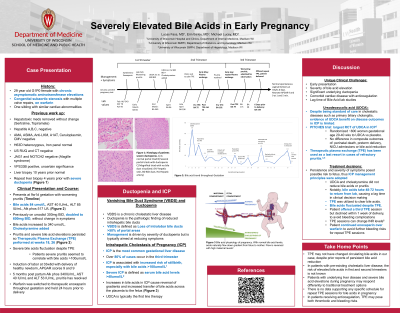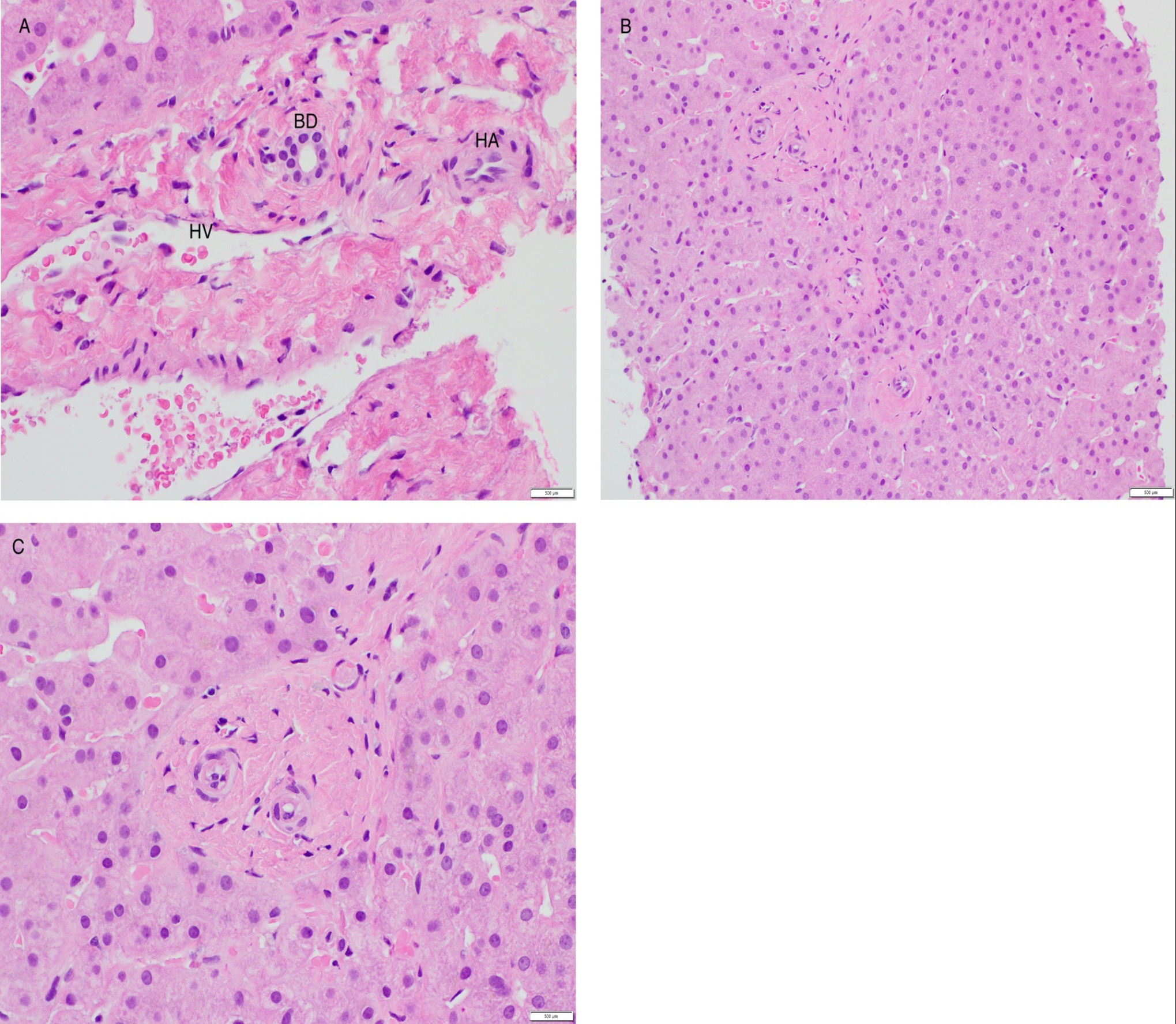Sunday Poster Session
Category: Liver
P1092 - Severely Elevated Bile Acids in Early Pregnancy
Sunday, October 22, 2023
3:30 PM - 7:00 PM PT
Location: Exhibit Hall

Has Audio

Lucas Fass, MD
University of Wisconsin Hospital and Clinics
Madison, WI
Presenting Author(s)
Lucas Fass, MD, Erin Bailey, MD, Michael Lucey, MD
University of Wisconsin Hospital and Clinics, Madison, WI
Introduction: Intrahepatic cholestasis of pregnancy (ICP) is the most common liver disease in pregnancy. ICP is characterized by new pruritus due to accumulated bile acids in the dermis. Over 80% of cases present in the third trimester and in patients without known liver disease. Severe ICP, defined as bile acids >40umol/L, is associated with increased risk of still birth. Here, we present a case of severely elevated bile acids in the first trimester in a woman with prior liver disease.
Case Description/Methods: A 29 year old G1P0 with congenital subaortic stenosis, valve repairs, and chronically elevated liver enzymes presented with worsening pruritus and elevated bile acids at 12 weeks gestation. The patient had had elevated liver enzymes for a decade. Previous workup was unrevealing. Liver biopsy ten years prior was normal. Repeat biopsy four years prior showed ductopenia with bile duct loss in >50% of portal tracts. Elastography demonstrated liver stiffness of 15.8kPa (normal < 7.5 kPa). The etiology of ductal loss was unclear, the underlying cause is presumed genetic. One sibling has similar cardiac anomalies. Extensive genetic testing however did not reveal a recognized abnormality. She had been maintained on Ursodiol for pruritus. Initial bile acids are 84 umol/L, Alk phos, AST, ALT are 517, 40, 85 U/L, respectively. Despite doubling ursodiol, bile acids increased to 340 umol/L. Cholestyramine was added, but bile acids remained >100. Plasma exchange was instituted during the second and third trimesters of gestation with minimal clinical impact. Induction of labor at 34 weeks resulted in a healthy child. Five months postpartum Alk phos, AST, ALT are 340, 40, 52 U/L, respectively. Bile acids are 21umol/L, elastography shows liver stiffness of 6.9kPa.
Discussion: Given that ICP occurs almost exclusively in the third trimester and may result in fetal loss, we were concerned that elevated bile acids throughout pregnancy would be harmful. Additionally, our patient had significant pruritus. We adopted principles of ICP. We encountered a lag of 2-3 days before receiving the bile acid results. This meant clinical decisions had to be based on symptoms and the most recent, but delayed, bile acid values. We conclude that our patient’s condition was due to her underlying bile duct injury plus the cholestatic effect of pregnancy. Second, in this case, pregnancy was successful with the birth of a healthy baby and postpartum maternal recovery, despite markedly elevated serum bile acids from week 12 until delivery.

Disclosures:
Lucas Fass, MD, Erin Bailey, MD, Michael Lucey, MD. P1092 - Severely Elevated Bile Acids in Early Pregnancy, ACG 2023 Annual Scientific Meeting Abstracts. Vancouver, BC, Canada: American College of Gastroenterology.
University of Wisconsin Hospital and Clinics, Madison, WI
Introduction: Intrahepatic cholestasis of pregnancy (ICP) is the most common liver disease in pregnancy. ICP is characterized by new pruritus due to accumulated bile acids in the dermis. Over 80% of cases present in the third trimester and in patients without known liver disease. Severe ICP, defined as bile acids >40umol/L, is associated with increased risk of still birth. Here, we present a case of severely elevated bile acids in the first trimester in a woman with prior liver disease.
Case Description/Methods: A 29 year old G1P0 with congenital subaortic stenosis, valve repairs, and chronically elevated liver enzymes presented with worsening pruritus and elevated bile acids at 12 weeks gestation. The patient had had elevated liver enzymes for a decade. Previous workup was unrevealing. Liver biopsy ten years prior was normal. Repeat biopsy four years prior showed ductopenia with bile duct loss in >50% of portal tracts. Elastography demonstrated liver stiffness of 15.8kPa (normal < 7.5 kPa). The etiology of ductal loss was unclear, the underlying cause is presumed genetic. One sibling has similar cardiac anomalies. Extensive genetic testing however did not reveal a recognized abnormality. She had been maintained on Ursodiol for pruritus. Initial bile acids are 84 umol/L, Alk phos, AST, ALT are 517, 40, 85 U/L, respectively. Despite doubling ursodiol, bile acids increased to 340 umol/L. Cholestyramine was added, but bile acids remained >100. Plasma exchange was instituted during the second and third trimesters of gestation with minimal clinical impact. Induction of labor at 34 weeks resulted in a healthy child. Five months postpartum Alk phos, AST, ALT are 340, 40, 52 U/L, respectively. Bile acids are 21umol/L, elastography shows liver stiffness of 6.9kPa.
Discussion: Given that ICP occurs almost exclusively in the third trimester and may result in fetal loss, we were concerned that elevated bile acids throughout pregnancy would be harmful. Additionally, our patient had significant pruritus. We adopted principles of ICP. We encountered a lag of 2-3 days before receiving the bile acid results. This meant clinical decisions had to be based on symptoms and the most recent, but delayed, bile acid values. We conclude that our patient’s condition was due to her underlying bile duct injury plus the cholestatic effect of pregnancy. Second, in this case, pregnancy was successful with the birth of a healthy baby and postpartum maternal recovery, despite markedly elevated serum bile acids from week 12 until delivery.

Figure: Figure 1: Histology of patients severe ductopenia. A) A normal portal triad B) Several portal triads without biliary ducts C) Magnified triad with no bile duct visualized. (HV hepatic vein, BD Bile duct, HA Hepatic artery)
Disclosures:
Lucas Fass indicated no relevant financial relationships.
Erin Bailey indicated no relevant financial relationships.
Michael Lucey indicated no relevant financial relationships.
Lucas Fass, MD, Erin Bailey, MD, Michael Lucey, MD. P1092 - Severely Elevated Bile Acids in Early Pregnancy, ACG 2023 Annual Scientific Meeting Abstracts. Vancouver, BC, Canada: American College of Gastroenterology.
